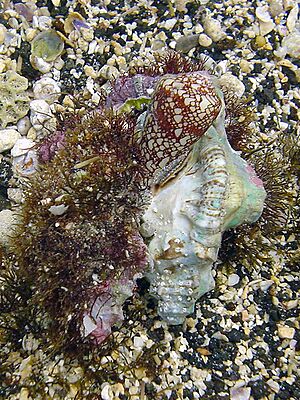Conus pennaceus facts for kids
Quick facts for kids Conus pennaceus |
|
|---|---|
 |
|
| Apertural and abapertural views of shell of Conus pennaceus Born, I. von, 1778 | |
 |
|
| Conservation status | |
| Scientific classification | |
| Synonyms | |
|

Conus pennaceus, often called the feathered cone or the episcopal cone, is a type of sea snail. It is a marine gastropod mollusk that belongs to the Conidae family. This family includes all the amazing cone snails and their relatives.
Like all cone snails, these creatures are predatory, meaning they hunt other animals for food. They are also venomous. This means they can "sting" humans. Because of their venom, it is very important to be careful with live cone snails. It is best not to touch them at all.
Contents
What is a Feathered Cone Snail?
The feathered cone snail is a fascinating marine animal. It lives in the ocean and is known for its beautiful shell. These snails are part of a large group of animals called mollusks.
Different Types of Feathered Cone Snails
Within the Conus pennaceus species, there are a few different types, called subspecies. They are very similar but have small differences.
- Conus pennaceus pennaceus Born, 1778
- Conus pennaceus pseudoecho (Bozzetti, 2013)
- Conus pennaceus vezoi Korn, Niederhöfer & Blöcher, 2000
Some snails that were once thought to be subspecies of Conus pennaceus are now considered separate species. For example:
- Conus pennaceus behelokensis Lauer, 1989 is now known as Conus behelokensis.
- Conus pennaceus echo Lauer, 1988 is now known as Conus echo.
What Does the Feathered Cone Snail Look Like?
The shell of an adult feathered cone snail can be between 35 mm (about 1.4 inches) and 88 mm (about 3.5 inches) long. That's roughly the size of a small candy bar to a large cell phone!
The shell's color can be orange-brown to a dark chocolate brown. It is covered with tiny white spots. On top of these, there are larger white spots that look like triangles. These triangular spots sometimes form bands around the shell's top, middle, and bottom.
Where Do Feathered Cone Snails Live?
You can find Conus pennaceus snails in the Indian Ocean. They live off the coasts of countries like Mozambique and Kenya. The main type of this snail lives along the shores of tropical Eastern Africa.
The shells of these snails can look very different depending on where they live. They often have a background color that is bluish or grayish. On top of this, they have patterns that are orange to reddish-brown. Some shells have a very wide top part, which is quite rare. Other forms have many tent-like patterns close together, making the shell look darker.
Gallery
Here are some examples of the different colors and patterns you might see on Conus pennaceus shells:










